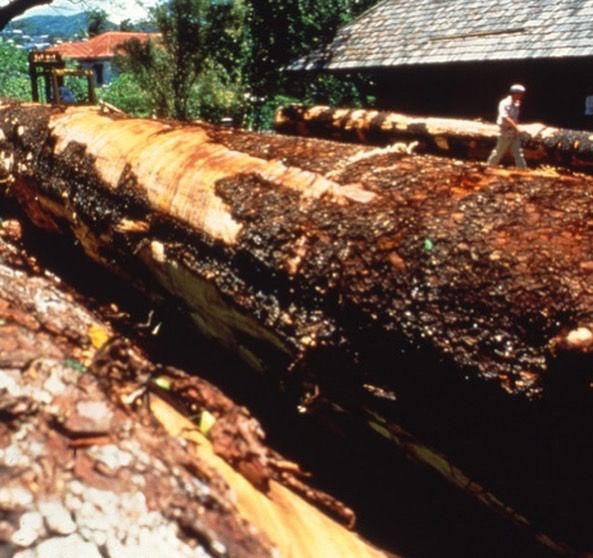This mo‘olelo is part of Kūkahekahe – Cultural Conversations – featuring personal experiences and insights from faculty, staff and friends about compelling cultural happenings within the KS organization, throughout the Hawaiian Islands, and across the larger Pacific and global communities.
As we seek to better understand what it means to be ʻōiwi leaders at Kamehameha Schools, we recall an especially poignant example of the multi-faceted nature of leadership and its ability to alter the path of history for generations.
In 1976, the voyaging canoe Hōkūleʻa sailed from Hawaiʻi to Tahiti, proving to the scientific community that our Polynesian ancestors navigated across Moananuiākea, the Pacific Ocean, without the use of instruments. The successful sails of Hōkūleʻa and the reclamation of wayfinding knowledge resulted in a renaissance that rippled throughout Hawaiʻi and the Pacific to revitalize our languages, histories, and cultures.
Hōkūleʻa’s voyages were revolutionary, the wayfinding knowledge of its navigators and sailing of its crews extraordinary. However, while these voyages could be accomplished without contemporary instruments, Hōkūleʻa itself was made using modern materials.
In 1990, with eyes on the future, the Polynesian Voyaging Society (PVS) developed a plan to build a canoe using indigenous materials of Hawaiʻi that were traditionally used in canoe-making. Kamehameha Schools land managers and members of PVS scouted for trees in our vast koa forests, but to no avail; many parts of our islands had been deforested and eco-systems were seriously threatened to the point where there were no longer healthy koa trees that were easily accessible and large enough to build a waʻa kaulua (double-hulled canoe) for long-distance voyaging.
Remembering that trees which had drifted across the ocean were another traditional source of canoe-building material for our ancestors, noted artist-historian and PVS co-founder Herb Kane presented the situation to Tlingit elder Judson Brown – who was chairman of the Sealaska Foundation, and Byron Mallott – then CEO of the Sealaska Corporation.
Sealaska gifted two of their cherished Sitka spruce trees from Shelikof in Soda Bay, Prince of Wales Island, west of Ketchikan to PVS. Finding the trees required months of reconnaissance, and when they were found deep in the forest, a special road had to be built to bring them out.
Ceremonies that hadn’t been seen in generations were performed to mark the cutting and transport of the trees. Tlingit elder Albert Kookesh shared at the 2019 Alaska-Hawaiʻi Hoʻoilina Conference that cutting these trees was of no small cultural significance – ancient giants, their biological, spiritual, and ancestral role in the forest compounded their importance to Alaska natives and to the land itself.
These priceless gifts were given with humility and unparalleled aloha. For Brown, Mallot and other members of Sealaska and Alaska Native communities, knowing that the trees would become a treasured canoe, a vehicle for Native Hawaiians to reclaim our culture, was motivation enough for the tremendous effort and resources it took to provide this gift.
This act of ʻōiwi leadership is emblematic of the indigenous principles of generosity and kindness – the notion that wealth is measured not by what we accumulate for ourselves but what we provide for the benefit of others.
Hawaiʻiloa was built from the spruce and launched in 1993. To express gratitude for the generous gift of trees, Hawaiʻiloa and its crew voyaged to Southeast Alaska in the summer of 1995 for a visit. The gifts of the trees also inspired increased interest and investment in KSʻ koa reforestation program.
Pwo navigator Nainoa Thompson recalls, “Judson Brown was there at the tree-planting ceremony. He was the spiritual link between his people and ours. At the koa forest he said, ‘When you sail, don't be afraid, because when you take your voyage we will be with you. When the north wind blows, take a moment to recognize that the wind is our people sailing with you.’”
In reflecting on Hawaiʻiloa and the voyage to Alaska in 1995, Thompson recollects, “When our ancestors built and sailed voyaging canoes, it required the labor and arts of the entire community.” Hawaiʻiloa and all of the voyages that have followed are more than the products of a single community, but the collective legacies of a treasured relationship that bridges Moananuiākea and unites our Pacific peoples as ʻōiwi.
VIEW THE LATEST PACIFIC CONVERSATIONS PROGRAM
Pacific Conversations is a monthly virtual talk show hosted by KS Cultural Consultant Snowbird Bento KSK’93 and Cultural Specialist Lāiana Kanoa-Wong. It celebrates indigenous peoples and places throughout Monananuiākea – the Great Pacific.
This month’s program, “Alaska Native Canoe Legacy: ‘Ōiwi Leadership Values,” features conversations with our partners at Sealaska Corporation and the Central Council for Tlingit and Haida Indians Tribes. Together they share the mo‘olelo of Alaska’s gift of two cherished Sitka spruce trees from Shelikof for the building of a Hawaiian voyaging canoe.

The two Sitka spruce logs that would become Hawaiʻiloa. Photo courtesy of the Polynesian Voyaging Society.

Hawaiʻiloa in waters off of Bishop Bay, Alaska in 1995.
TAGS
pacific conversations,
aha moananuiākea pacific consortium,
kūkahekahe
CATEGORIES
Kaipuolono Article, Regions, Themes, Culture, Community, Leadership, Hawaii Newsroom, KS Hawaii Home, Kapalama Newsroom, Kapalama Home, Maui Newsroom, KS Maui Home, Newsroom, Campus Programs, Hawaii, Kapalama, Maui, Community Education, Department News, Ho‘okahua, Mālama Honua, News Briefs
Print with photos
Print text only










